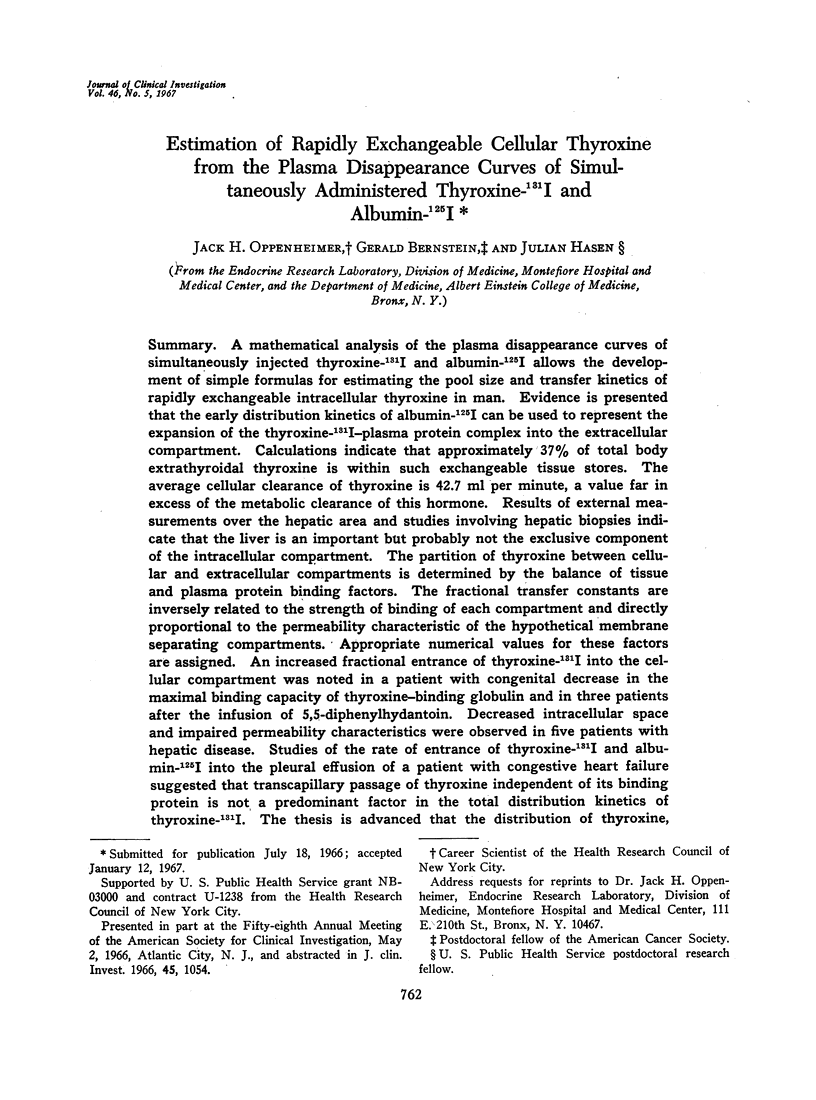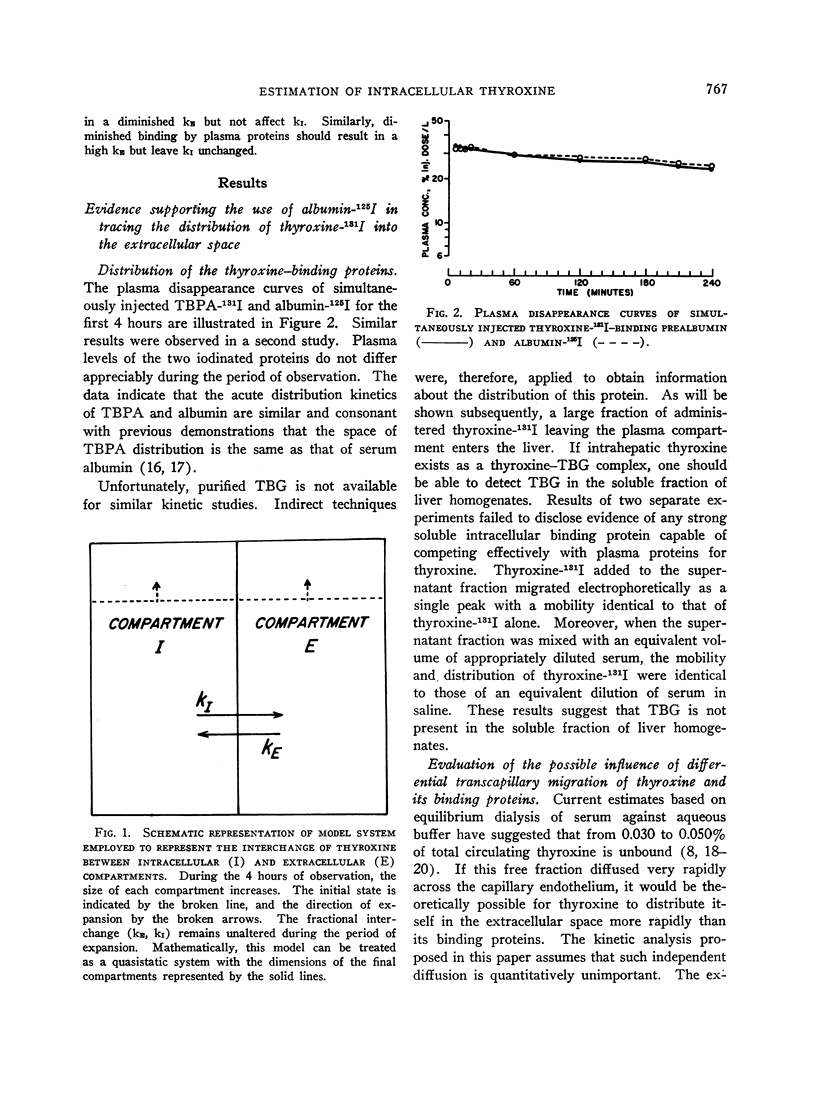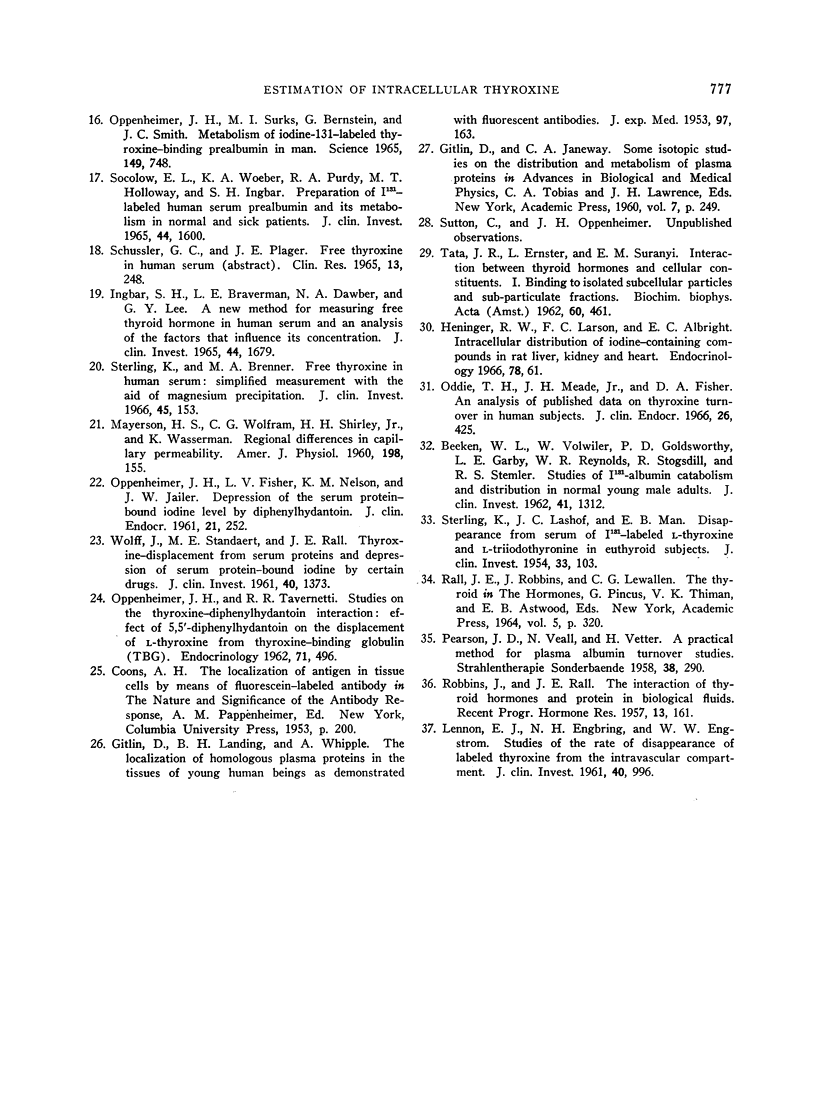Abstract
A mathematical analysis of the plasma disappearance curves of simultaneously injected thyroxine-131I and albumin-125I allows the development of simple formulas for estimating the pool size and transfer kinetics of rapidly exchangeable intracellular thyroxine in man. Evidence is presented that the early distribution kinetics of albumin-125I can be used to represent the expansion of the thyroxine-131I-plasma protein complex into the extracellular compartment. Calculations indicate that approximately 37% of total body extrathyroidal thyroxine is within such exchangeable tissue stores. The average cellular clearance of thyroxine is 42.7 ml per minute, a value far in excess of the metabolic clearance of this hormone. Results of external measurements over the hepatic area and studies involving hepatic biopsies indicate that the liver is an important but probably not the exclusive component of the intracellular compartment. The partition of thyroxine between cellular and extracellular compartments is determined by the balance of tissue and plasma protein binding factors. The fractional transfer constants are inversely related to the strength of binding of each compartment and directly proportional to the permeability characteristic of the hypothetical membrane separating compartments. Appropriate numerical values for these factors are assigned. An increased fractional entrance of thyroxine-131I into the cellular compartment was noted in a patient with congenital decrease in the maximal binding capacity of thyroxine-binding globulin and in three patients after the infusion of 5,5-diphenylhydantoin. Decreased intracellular space and impaired permeability characteristics were observed in five patients with hepatic disease. Studies of the rate of entrance of thyroxine-131I and albumin-125I into the pleural effusion of a patient with congestive heart failure suggested that transcapillary passage of thyroxine independent of its binding protein is not a predominant factor in the total distribution kinetics of thyroxine-131I. The thesis is advanced that the distribution of thyroxine, both within the extracellular compartment and between the extracellular and intracellular compartments, is accomplished largely by the carrier protein and the direct transfer of thyroxine from one binding site to another. The concept of free thyroxine is reassessed in terms of this formulation.
Full text
PDF















Selected References
These references are in PubMed. This may not be the complete list of references from this article.
- ADAMS W. S., MASON E. D., BASSETT S. H. Metabolic balance investigation of three cases of multiple myeloma during ACTH administration; exchanges of calcium, phosphorus, nitrogen and electrolytes. J Clin Invest. 1954 Feb;33(2):103–121. doi: 10.1172/JCI102877. [DOI] [PMC free article] [PubMed] [Google Scholar]
- ALBERT A., KEATING F. R., Jr The role of the gastrointestinal tract, including the liver, in the metabolism of radiothyroxine. Endocrinology. 1952 Nov;51(5):427–443. doi: 10.1210/endo-51-5-427. [DOI] [PubMed] [Google Scholar]
- BEEKEN W. L., VOLWILER W., GOLDSWORTHY P. D., GARBY L. E., REYNOLDS W. E., STOGSDILL R., STEMLER R. S. Studies of I-131-albumin catabolism and distribution in normal young male adults. J Clin Invest. 1962 Jun;41:1312–1333. doi: 10.1172/JCI104594. [DOI] [PMC free article] [PubMed] [Google Scholar]
- BERSON S. A., YALOW R. S. The iodide trapping and binding functions of the thyroid. J Clin Invest. 1955 Feb;34(2):186–204. doi: 10.1172/JCI103072. [DOI] [PMC free article] [PubMed] [Google Scholar]
- Cavalieri R. R., Searle G. L. The kinetics of distribution between plasma and liver of 131-I-labeled L-thyroxine in man: observations of subjects with normal and decreased serum thyroxine-binding globulin. J Clin Invest. 1966 Jun;45(6):939–949. doi: 10.1172/JCI105409. [DOI] [PMC free article] [PubMed] [Google Scholar]
- GITIL D., LANDING B. H., WHIPPLE A. The localization of homolgous plasma proteins in the tissues of young human beings as demonstrated with fluorescent antibodies. J Exp Med. 1953 Feb 1;97(2):163–176. doi: 10.1084/jem.97.2.163. [DOI] [PMC free article] [PubMed] [Google Scholar]
- GITLIN D., JANEWAY C. A. Some isotopic studies on the distribution and metabolism of plasma proteins. Adv Biol Med Phys. 1960;7:249–293. doi: 10.1016/b978-1-4832-3113-6.50009-9. [DOI] [PubMed] [Google Scholar]
- GREENWOOD F. C., HUNTER W. M., GLOVER J. S. THE PREPARATION OF I-131-LABELLED HUMAN GROWTH HORMONE OF HIGH SPECIFIC RADIOACTIVITY. Biochem J. 1963 Oct;89:114–123. doi: 10.1042/bj0890114. [DOI] [PMC free article] [PubMed] [Google Scholar]
- Gorman C. A., Flock E. V., Owen C. A., Jr, Paris J. Factors affecting exchange of thyroid hormones between liver and blood. Endocrinology. 1966 Aug;79(2):391–405. doi: 10.1210/endo-79-2-391. [DOI] [PubMed] [Google Scholar]
- HAZELRIG J. B. THE IMPACT OF HIGH-SPEED AUTOMATED COMPUTATION ON MATHEMATICAL MODELS. Mayo Clin Proc. 1964 Nov;39:841–848. [PubMed] [Google Scholar]
- Heninger R. W., Larson F. C., Albright E. C. Intracellular distribution of iodine-containing compounds in rat liver, kidney and heart. Endocrinology. 1966 Jan;78(1):61–66. doi: 10.1210/endo-78-1-61. [DOI] [PubMed] [Google Scholar]
- Ingbar S. H., Braverman L. E., Dawber N. A., Lee G. Y. A new method for measuring the free thyroid hormone in human serum and an analysis of the factors that influence its concentration. J Clin Invest. 1965 Oct;44(10):1679–1689. doi: 10.1172/JCI105275. [DOI] [PMC free article] [PubMed] [Google Scholar]
- LENNON E. J., ENGBRING N. H., ENGSTROM W. W. Studies of the rate of disappearance of labeled thyroxine from the intravascular compartment. J Clin Invest. 1961 Jun;40:996–1005. doi: 10.1172/JCI104339. [DOI] [PMC free article] [PubMed] [Google Scholar]
- OPPEHNEIMER J. H., SURKS M. I., BERNSTEIN G., SMITY J. C. METABOLISM OF IODINE-131--LABELED THYROXINE-BINDING PREALBUMIN IN MAN. Science. 1965 Aug 13;149(3685):748–750. doi: 10.1126/science.149.3685.748. [DOI] [PubMed] [Google Scholar]
- OPPENHEIMER J. H., FISHER L. V., NELSON K. M., JAILER J. W. Depression of the serum protein-bound iodine level by diphenylhydantion. J Clin Endocrinol Metab. 1961 Mar;21:252–262. doi: 10.1210/jcem-21-3-252. [DOI] [PubMed] [Google Scholar]
- OPPENHEIMER J. H., SQUEF R., SURKS M. I., HAUER H. BINDING OF THYROXINE BY SERUM PROTEINS EVALUATED BY EQUILIBRUM DIALYSIS AND ELECTROPHORETIC TECHNIQUES. ALTERATIONS IN NONTHYROIDAL ILLNESS. J Clin Invest. 1963 Nov;42:1769–1782. doi: 10.1172/JCI104862. [DOI] [PMC free article] [PubMed] [Google Scholar]
- OPPENHEIMER J. H., SURKS M. I. DETERMINATION OF FREE THYROXINE IN HUMAN SERUM: A THEORETICAL AND EXPERIMENTAL ANALYSIS. J Clin Endocrinol Metab. 1964 Aug;24:785–793. doi: 10.1210/jcem-24-8-785. [DOI] [PubMed] [Google Scholar]
- OPPENHEIMER J. H., SURKS M. I., SMITH J. C., SQUEF R. ISOLATION AND CHARACTERIZATION OF HUMAN THYROXINE-BINDING PREALBUMIN. J Biol Chem. 1965 Jan;240:173–180. [PubMed] [Google Scholar]
- OPPENHEIMER J. H., TAVERNETTI R. R. Studies on the thyroxine-diphenylhydantoin interaction: effect of 5,5'-diphenylhydantoin on the displacement of L-thyroxine from thyroxine-binding globulin (TBG). Endocrinology. 1962 Sep;71:496–504. doi: 10.1210/endo-71-3-496. [DOI] [PubMed] [Google Scholar]
- Oddie T. H., Meade J. H., Jr, Fisher D. A. An analysis of published data on thyroxine turnover in human subjects. J Clin Endocrinol Metab. 1966 Apr;26(4):425–436. doi: 10.1210/jcem-26-4-425. [DOI] [PubMed] [Google Scholar]
- PEARSON J. D., VEALL N., VETTER H. A practical method for plasma albumin turnover studies. Strahlentherapie. 1958;107(SONDERBD):290–297. [PubMed] [Google Scholar]
- ROBBINS J., RALL J. E. The interaction of thyroid hormones and protein in biological fluids. Recent Prog Horm Res. 1957;13:161–208. [PubMed] [Google Scholar]
- SOLOMON A. K. Equations for tracer experiments. J Clin Invest. 1949 Nov;28(6 Pt 1):1297–1307. doi: 10.1172/JCI102197. [DOI] [PMC free article] [PubMed] [Google Scholar]
- Smith J. C., Bernstein G., Surks M. I., Oppenheimer J. H. A method of preparative starch-gel electrophoresis. Biochim Biophys Acta. 1966 Jan 25;115(1):81–87. doi: 10.1016/0304-4165(66)90051-1. [DOI] [PubMed] [Google Scholar]
- Socolow E. L., Woeber K. A., Purdy R. H., Holloway M. T., Ingbar S. H. Preparation of I-131-labeled human serum prealbumin and its metabolism in normal and sick patients. J Clin Invest. 1965 Oct;44(10):1600–1609. doi: 10.1172/JCI105266. [DOI] [PMC free article] [PubMed] [Google Scholar]
- Sterling K., Brenner M. A. Free thyroxine in human serum: simplified measurement with the aid of magnesium precipitation. J Clin Invest. 1966 Jan;45(1):153–163. doi: 10.1172/JCI105320. [DOI] [PMC free article] [PubMed] [Google Scholar]
- TATA J. R., ERNSTER L., SURANYI E. M. Interaction between thyroid hormones and cellular constituents. I. Binding to isolated sub-cellular particles and sub-particulate fractions. Biochim Biophys Acta. 1962 Jul 16;60:461–479. doi: 10.1016/0006-3002(62)90866-1. [DOI] [PubMed] [Google Scholar]
- Volpert E. M., Martinez M., Oppenheimer J. H. Radioiodinated impurities in commercial preparations of 131-I-thyroxine and their effect on the measurement of free thyroxine in human serum by equilibrium dialysis. J Clin Endocrinol Metab. 1967 Mar;27(3):421–428. doi: 10.1210/jcem-27-3-421. [DOI] [PubMed] [Google Scholar]
- WOLFF J., STANDAERT M. E., RALL J. E. Thyroxine displacement from serum proteins and depression of serum protein-bound iodine by certain drugs. J Clin Invest. 1961 Aug;40:1373–1379. doi: 10.1172/JCI104368. [DOI] [PMC free article] [PubMed] [Google Scholar]


